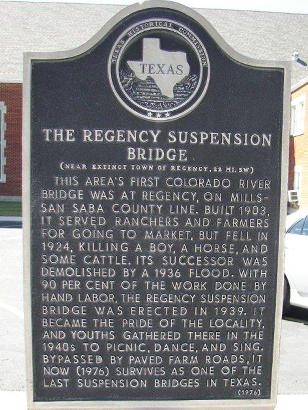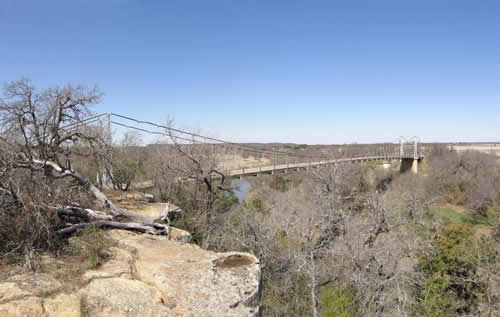|
When
you’re standing on a suspension bridge and the span begins to bounce
as a car starts across, it may be necessary to suspend an instinctive
urge to run.
This is especially true with the Regency
Bridge, which crosses the Colorado River 23 miles from Goldwaithe
to link Mills and
San Saba counties.
Looking down at the river below, a normally robust appears to be considerably
smaller.
Suppressing hard-wired flight impulses can be even more difficult
if you’ve pulled off Mills County Road 127 to read the 1976-vintage
historical marker summarizing the bridge’s history. The first
bridge on this site was built in 1903. That structure, a traditional
truss bridge, lasted only 23 years – practically a blink of an eye
when it comes to public infrastructure typically designed to last
a half-century or more. |
 |
Unfortunately,
what the first bridge’s builder surely considered impossible happened
on May 9, 1924 when a rancher and his two sons pushed a herd
of cattle across the bridge. The structure gave way under the weight
of the livestock and fell to the river below. The father and one son
managed to make it to the other side. But the other boy, only nine,
plummeted to his death along with numerous cattle.
The turn-of-the-century bridge had not been subject to a lot of traffic,
but it was the only bridge for miles around, so Mills and San Saba
county officials proceeded with having it rebuilt as soon as possible.
With no state money used, a new bridge opened in 1931. All went well
until the spring of 1936, when a torrential flood washed the
second bridge away.
In 1939, the Dallas-based
Austin Bridge Co. won the contract to erect a third suspension bridge
at a cost of $30,000. Workers earning 30 cents an hour added concrete
to the earlier bridge’s piers to raise it above flood stage and hand-strung
the 475 lengths of wire forming each of the four cables that suspend
the bridge over the river. |
 |
“And brother, we worked,” Lamar Morris told a writer for Texas Highways
Magazine back in 1970. “Had to. There was always someone who was huntin’
a job there to take your place.”
Ninety percent of the work was done by hand. The rest took only one
gasoline-powered concrete mixer, a winch truck and a steam shovel.
The bridge is supported by four 3.25-inch thick steel cables connected
to two welded-steel towers on each side of the river. The main span
is 343 feet long, but counting the approach spans, engineers list
the bridge’s overall length at 403 feet. The wooden deck of the bridge
is 16 feet across.
Long
before a bridge crossed the Colorado at this point, a pioneer named
David Hanna settled in the area in 1854. He used two
slaves to grow crops in the fertile river valley. Later, David’s four
brothers and his father came to the area and stayed. The reason they
didn’t move on, at least according to legend, is that their wives
liked listening to all the songbirds in the trees along the river’s
banks.
As other settlers arrived, the area became known as Hanna.
That name stuck until the citizens applied for a post office and found
some other place had the same name, so the community was renamed Regency.
By 1890, 50 families supported a general store, church, cotton gin
and gristmill. Five years later, the population hit 200, the largest
it would get.
The post office closed in the 1930s and the last store went out of
business in 1971.
Barely
three decades after its construction, the bridge’s days seemed numbered.
The Texas Department of Transportation, then more simply known as
the Highway Department, had plans to demolish the bridge in 1971 and
span the river with a new concrete structure.
That plan never materialized, but by the early 1990s, the pre-World
War II bridge had really begun to show its age. With an infusion
of federal funds earmarked for bridge restoration projects plus 15
percent in state and county money, TxDOT engineers oversaw the revitalization
of the bridge.
Then Gov. George W. Bush spoke at the span’s rededication in the spring
of 1999. Some 2,000 people showed up for the event.
The
most recent development in the bridge’s long history came on Dec.
29, 2003 when persons unknown started a fire on the span’s wooden
flooring. Now iron patches cover the holes burned through the planks.
Today, the New Deal-era bridge continues to handle a light traffic
flow, though its wooden planks have once again begun to show their
age. Most of the timbers are splintering and some nails have pulled
loose.
The Regency Bridge is one of only a pair of suspension bridges in
Texas still open to traffic, with four other such bridges still standing
but not in use.
© Mike Cox
"Texas Tales" December
6, 2013 column
More Texas Bridges
|
|
|
